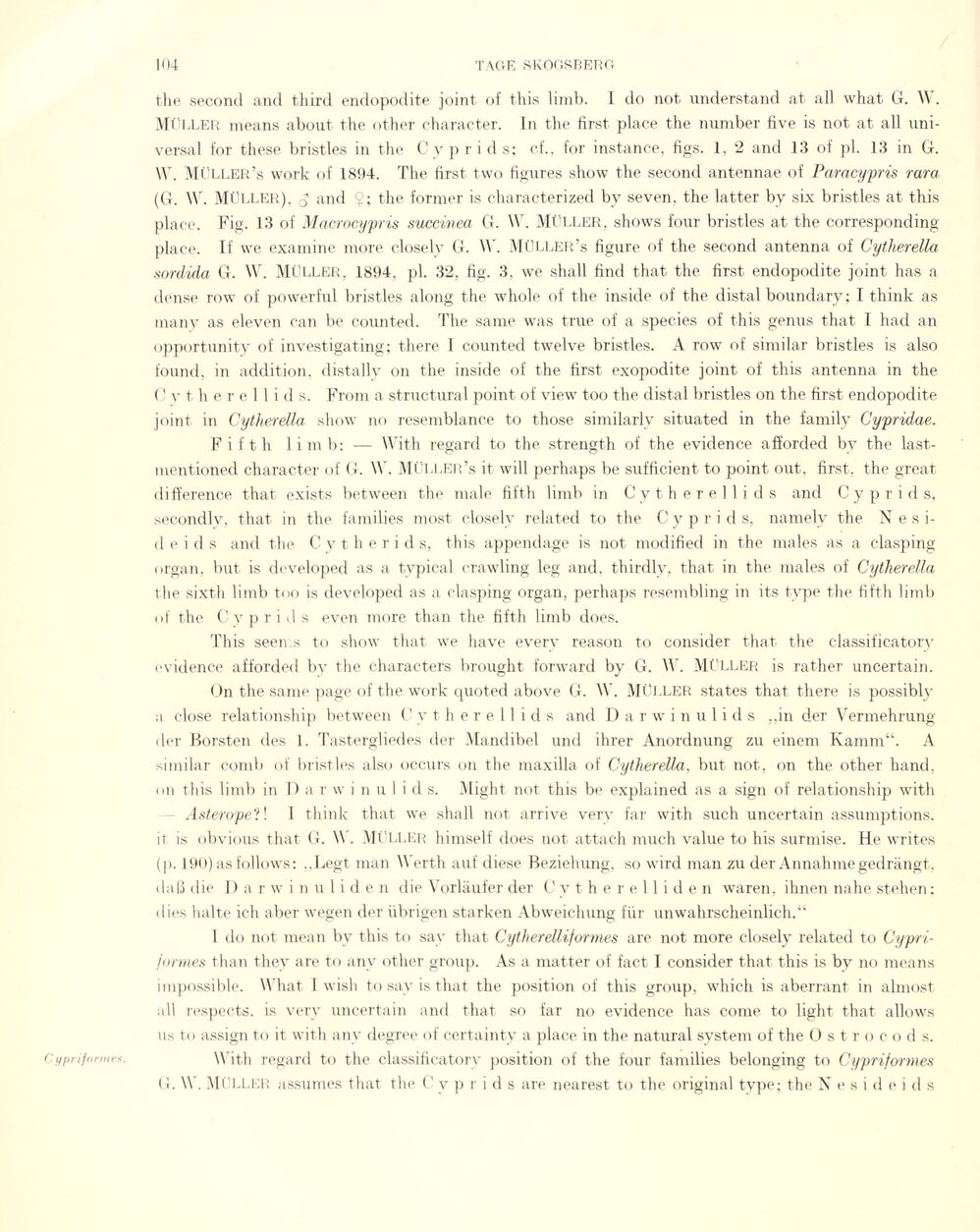
Full resolution (JPEG) - On this page / på denna sida - Sidor ...

<< prev. page << föreg. sida << >> nästa sida >> next page >>
Below is the raw OCR text
from the above scanned image.
Do you see an error? Proofread the page now!
Här nedan syns maskintolkade texten från faksimilbilden ovan.
Ser du något fel? Korrekturläs sidan nu!
This page has never been proofread. / Denna sida har aldrig korrekturlästs.
the second and third endopodite joint of this linib. I do not understand at all what G. \\ .
Müller means about the other character. In the first place the number five is not at all
universal for these bristles in the Cypri ds; cf., for instance, figs. 1, 2 and 13 of pl. 13 in G.
W. MüLLER’s work of 1894. The first two figures show the second antennae of Paracypris rava
(G. W. Müller), £ and Ç; the former is characterized by seven. the latter by six bristles at this
place. Fig. 13 of Macrocypris succinea G. W. MÜLLER, shows four bristles at the corresponding
place. If we examine more closely G. W. MüLLER’s figure of the second antenna of Cytherella
sordida G. W. Müller, 1894. pl. 32, fig. 3, we shall find that the first endopodite joint lias a
dense row of powerful bristles along the whole of the inside of the distal boundary; I think as
many as eleven can be counted. The same was true of a species of this genus that I had an
opportunity of investigating; tliere I counted twelve bristles. A row of similar bristles is also
found, in addition, distally on the inside of the first exopodite joint of this antenna in the
Cvtherellids. From a structural point of view too the distal bristles on the first endopodite
joint in Cytherella show no resemblance to those similarly situated in the family Cypridae.
Fifth li mb: — With regard to the strength of the evidence afforded by the
last-mentioned character of G. NV. MüLLER’s it will perhaps be sufficient to point out, first, the great
difference that existe between the male fifth limh in Cythereii ids and C y p r i d s,
secondly, that in the families most closely related to the C y p r i d s, namely the N e s
i-d e i d s and the Cytherids, this appendage is not modified in the males as a clasping
organ, but is developed as a typical crawling leg and, thirdly, that in the males of Cytherella
the sixth limb too is developed as a clasping organ, perhaps resembling in its type the fifth limb
of the Cypri ds even more than the fifth limb does.
This seems to show that we have every reason to consider that the classificatory
evidence afforded by the characters brought forward by G. W. MÜLLER is rather uncertain.
On the same page of the work quoted above G. W. MÜLLER states that there is possibly
a close relationship between Cvtherellids and Darwinulids ,,in der Vermehrung
der Borsten des 1. Tastergiiedes der Mandibel und ihrer Anordnung zu einem Kamm“. A
similar comb of bristles also occurs on the maxilla of Cytherella, but not, on the other hand,
on this limb in I) a r w i n u 1 i d s. Might not this be explained as a sign of relationship with
- Asteropel ! I think that we shall not arrive very far with such uncertain assumptions.
it is obvious that G. \V. Müller himself does not attach much value to his surmise. He writes
(p. 190) asfollows: ..Legt man Werth auf diese Beziehung, so wird man zu der Annahme gedrängt,
daß die Darwinuliden die Vorläufer der Cytherelliden waren, ihnen nahe stehen;
dies halte ich aber wegen der übrigen starken Abweichung für unwahrscheinlich.“
I do not mean by this to say that Cytherelliformes are not more closely related to
Cypri-farmes than they are to any other group. As a matter of faet I consider that this is by no means
impossible. What I wisli to say is that the position of this group, which is aberrant in almost
all respects, is very uncertain and that so far no evidence has come to light that allows
us to assign to it with any degree of certainty a place in the natural system of the Ostrocods.
With regard to the classificatory position of the four families belonging to Cypriformes
G. W. Müller assumes that the C y p rids are nearest to the original type; the N e s i d e i d s
y pri formes.
<< prev. page << föreg. sida << >> nästa sida >> next page >>